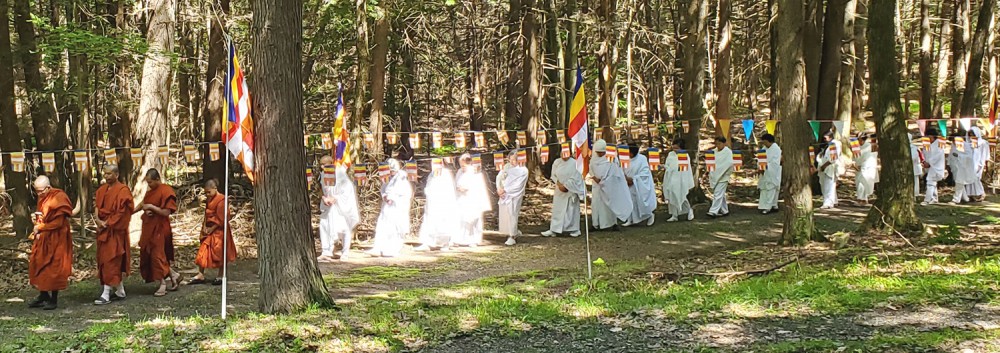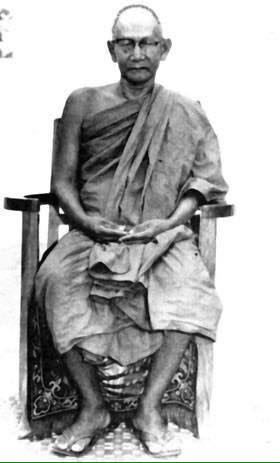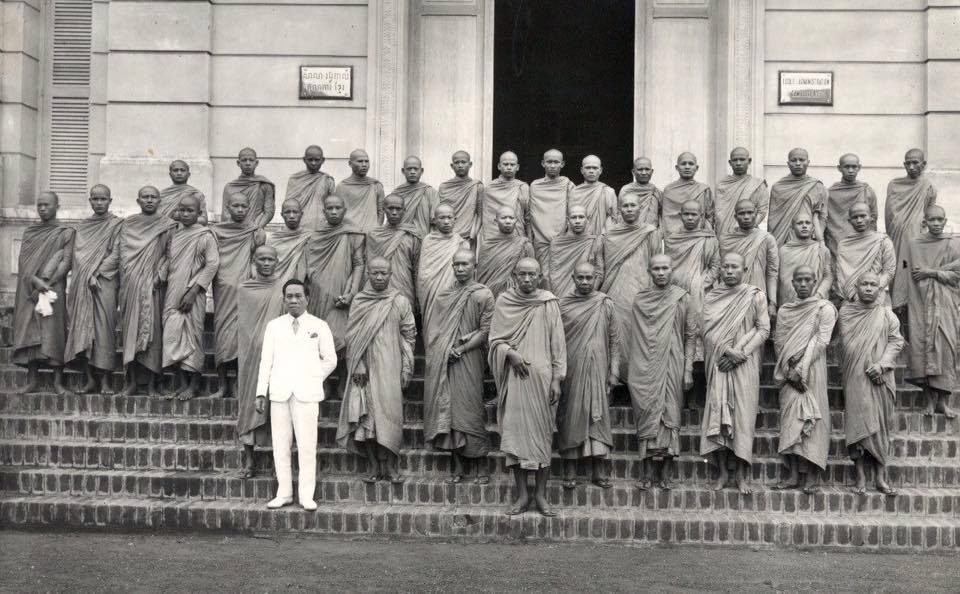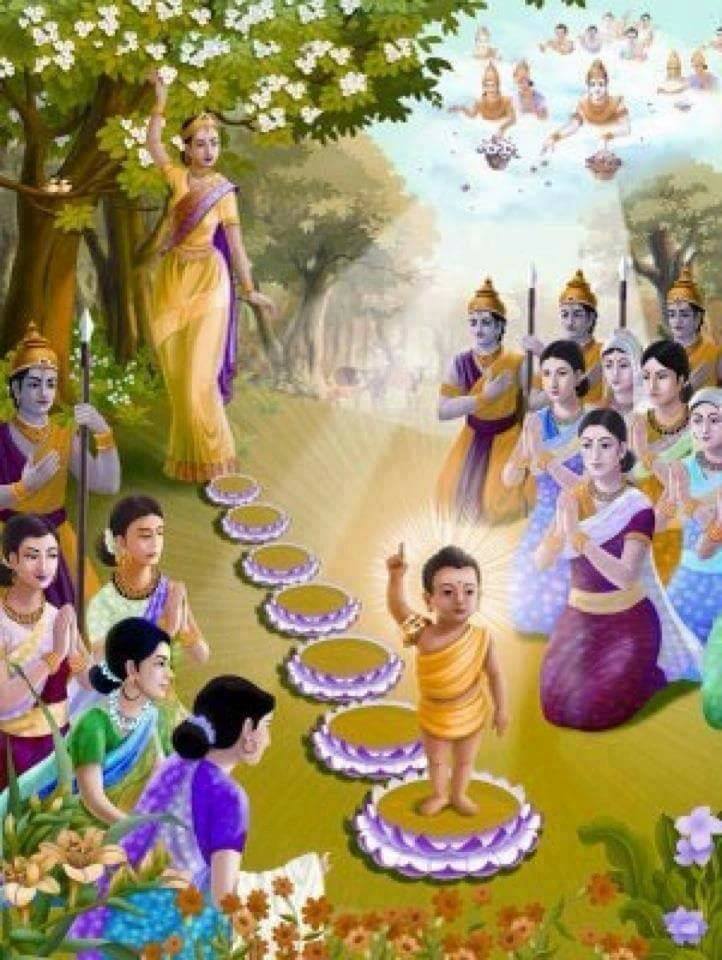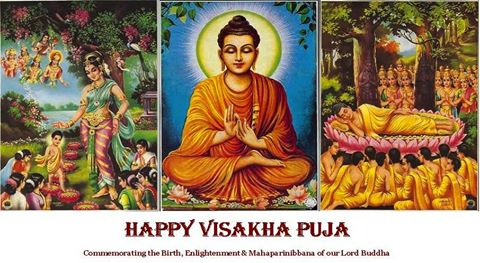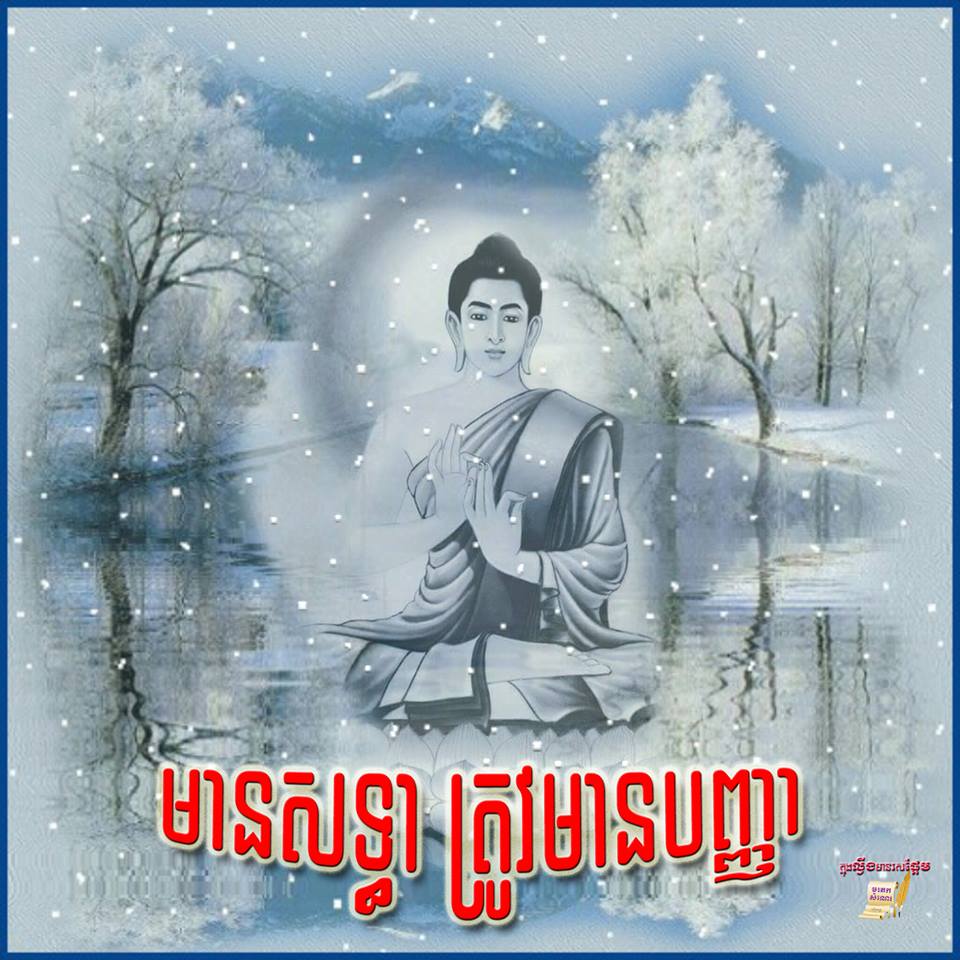ព្រះធម្មទេសនាស្តីពី បរិយត្តិ និង បដិបត្តិ និង ជំនឿត្រូវ ៤ យ៉ាង ក្នុងព្រះពុទ្ធសាសនា
ព្រះធម្មទេសនាស្តីពី បរិយត្តិ និង បដិបត្តិ និង ជំនឿត្រូវ ៤ យ៉ាង ក្នុងព្រះពុទ្ធសាសនា ដេាយ ព្រះធម្មវិបស្សនា កេតុធម្មោ សំ ប៊ុនធឿន
Dhamma talk on pariyatti and patipatti and the four types of faith in Buddhism by the late and renowned Cambodian Vipassana Buddhist Master Ven. Ketodhammo Som Bunthoeun.
សទ្ធាមាន ៤ យ៉ាងគឺ៖
១. កម្មសទ្ធា ការជឿកម្ម។
២. វិបាកសទ្ធា ការជឿផល។
៣. កម្មស្សកតាសទ្ធា ការជឿថាសត្វទំាងឡាយមានកម្មដែលខ្លួនធេី្វហើយ ជារបស់ខ្លួន។
៤. តថាគតពោធិសទ្ធា ការជឿសេចក្តីត្រាស់ដឹងរបស់ព្រះតថាគត។
សុទ្ធិ អសុទ្ធិ បច្ចត្តំ នាញ្ញោ អញ្ញំ វិសោធយេ
សេចក្ដីបរិសុទ្ធ និង មិនបរិសុទ្ធជារបស់ចំពោះខ្លួន អ្នកដទៃនឹងធើ្វអ្នកដទៃឱ្យបរិសុទ្ធ ពុំបានឡើយ។
ជំនឿក្រៅព្រះពុទ្ធសាសនា ដេាយ ព្រះធម្មវិបស្សនា កេតុធម្មោ សំ ប៊ុនធឿន
ព្រះធម្មទេសនា ស្តីពីជំនឿក្រៅព្រះពុទ្ធសាសនា ដេាយ ព្រះធម្មវិបស្សនា កេតុធម្មោ សំ ប៊ុនធឿន
“សត្វបរោខោ ទំមែកពោធិ៍ សុីផ្លែជ្រៃ”
Dhamma talk on Buddhism & Superstitions by the late and renowned Cambodian Vipassana Buddhist Master Ven. Ketodhammo Som Bunthoeun.
Superstition has no place in Buddhism.
Buddhism is strictly not a religion in the context of being a faith and worship owing allegiance to a supernatural being.
The Buddha rejects superstitions but urges us to pursue wisdom. The Buddha teaches us to develop the most important practices: self-discipline, self-restraint, cultivation of morality and spiritual development. The Buddha also teaches us to cultivate the strength of will-power, wisdom, understanding of Mind and self-nature.
ប្រវត្តិឆដ្ឋសង្គាយនា
ប្រវត្តិឆដ្ឋសង្គាយនា (លើកទី ៦) ដ៏មហាអស្ចារ្យនេះ
History of the Chaṭṭha Saṅgāyana, The Sixth Great International Buddhist Council
ថ្ងៃចន្ទ ៤កើត ខែជេស្ឋ ឆ្នាំជូត ទោស័ក ព.ស.២៥៦៤ ត្រូវនឹងថ្ងៃទី២៥ ខែឧសភា គ.ស.២០២០
Monday the 4th Waxing Moon of Jeṭṭha B.E.2564 equivalent to May 25, A.D.2020 Year of the Rat
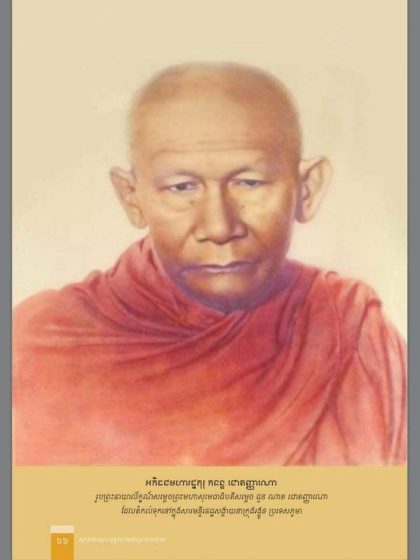
សង្គាយនា គឺជាឈ្មោះនៃកិច្ចប្រជុំរបស់ព្រះភិក្ខុសង្ឃក្នុងព្រះពុទ្ធសាសនា ដើម្បីផ្ទៀងផ្ទាត់ធម៌វិន័យដែលជាពាក្យប្រៀនប្រដៅរបស់ព្រះពុទ្ធអង្គ ទុកស្មើនឹងព្រះសម្មាសម្ពុទ្ធផ្ទាល់ព្រះអង្គ គង់នៅដូចជា ព្រះពុទ្ធដីកាថា
យោ វោ អានន្ទ មយា ធម្មោ ច វិនយោ ច ទេសិតោ បញ្ញត្តោ សោ វោ សត្ថា
ម្នាលអានន្ទ ធម៌វិន័យឯណា ដែលព្រះតថាគត បានសម្តែងហើយនឹងបញ្ញត្តហើយ ដល់អ្នកទាំងឡាយ ធម្មវិន័យនោះ នឹងជាគ្រូរបស់អ្នកទាំងឡាយ ដោយកាលជាអំណឹះតទៅនៃតថាគត ។
ដោយរយៈកាលជាអំណឹះទៅនៃព្រះពុទ្ធបរមគ្រូ មានបញ្ហាចម្រូងចម្រាសកើតឡើងចំពោះធម្មវិន័យ ក្នុងពុទ្ធសាសនមណ្ឌល ទើបព្រះមហាថេរៈទាំងឡាយ ជាគណាចារ្យបានរៀបចំជាសង្គាយនាឡើង ដើម្បីផ្ទៀងផ្ទាត់នឹងរក្សាឱ្យបាននូវទម្រង់ដើមនៃព្រះពុទ្ធវចនៈ ដែលជាពាក្យរបស់ព្រះពុទ្ធសុទ្ធៗ ដើម្បីជាប្រយោជន៍ ដើម្បីសេចក្តីសុខដល់ជនច្រើនអស់កាលជាយូរអង្វែងតទៅ ។
ឆដ្ឋសង្គាយនា លើកទី ៦នេះ ប្រារព្ធឡើងនៅព.ស.២៤៩៨ឆ្នាំ ក្រោយព្រះពុទ្ធបរិនិព្វាន ទីតាំង ល្អាងភ្នំសិប្បនិម្មិត មហាបាសាណាគុហា (Mahapasana Cave) ក្រុងយុាំងហ្គូន ប្រទេសភូមា ទំនុកបម្រុងដោយរដ្ឋាភិបាលភូមា ដឹកនាំដោយព្រះរេវតមហាថេរៈ ភទន្តសោភណៈ ជាបុច្ឆកៈ និង ព្រះតិបិដកធរធម្មភណ្ឌាគារិកវិចិត្តសារាភិវំសៈ ជាវិសជ្ជកៈ មានព្រះភិក្ខុសង្ឃ ២.៥០០អង្គ ដោយចូលរួមមានប្រតិភូសង្ឃមកពីបណ្តាប្រទេសកាន់ព្រះពុទ្ធសាសនាថេរវាទដូចគ្នា មាន៖ ភូមា កម្ពុជា សៀម លាវ ស្រីលង្កា និងបណ្តាប្រទេសផ្សេងៗទៀត ចូលរួមផងដែរ ។ ប្រារព្ធឡើងរយៈពេល ២ឆ្នាំ មូលហេតុ ដើម្បីផ្ទៀងផ្ទាត់ធម្មវិន័យ និងចងក្រងព្រះពុទ្ធវចនៈ ពោលគឺព្រះត្រៃបិដក ព្រមទាំងអដ្ឋកថា ដីកា យោជនា និងគន្ថៈផ្សេងៗ មានគម្ពីរវេយ្យាករណ៍ ជាដើម បានជាឯកសាររួមរបស់ព្រះពុទ្ធសាសនាថេរវាទ ។
• ព្រះអគ្គមហាបណ្ឌិត ភទន្តៈ សោភណៈ (មហាសីស្យាដ័រ) ជាបុច្ឆកត្ថេរ (អ្នកសួរ) ព្រះមហាថេរៈអង្គនេះ ប្រជាជនភូមាជឿជាក់ថា ជាព្រះអនាគាមិបុគ្គល។
• ព្រះតិដកធរធម្មភណ្ឌាគារិកៈ ភទន្តៈ វិចិត្តសារាភិវំសៈ ជាវិសជ្ជកៈ (អ្នកឆ្លើយ) ព្រះមហាថេរៈអង្គនេះ ចេះចាំព្រះត្រៃបិដកទាំងបីសូត្រមាត់ទទេបានសព្វគ្រប់។
ទីតាំងធ្វើសង្គាយនា និងទីស្នាក់នៅរបស់ព្រះភិក្ខុសង្ឃ មហាបាសាណាគុហា ជាភ្នំសិប្បនិម្មិតតូចល្មមមួយ មានបណ្តោយប្រវែង ៤៥៤ហត្ថ និងទទឹង ៣៧០ហត្ថ មានរូងភ្នំ នៅខាងក្នុង ដែលមានបណ្តោយប្រវែង ២២០ ហត្ថ ទទឹង ១៤០ហត្ថ មានទ្វារធំៗ ៦ និងប្រហោង ៣ខាងលើ ច្រកចូលទ្វារធំ តំណាងព្រះរតនត្រ័យ និងជុំវិញ មានប្រហោង ២៤ទៀត ជាបង្អួចតំណាងបច្ច័យទាំង ២៤ ក្នុងគម្ពីរមហាដ្ឋាន (អភិធម្ម) ដែលចំណាយលើថ្លៃកសាងអស់ ៩២សែនរូពី។ ឯកន្លែងស្នាក់អាស្រ័យរបស់ព្រះភិក្ខុសង្ឃវិញ ក៏ស្ថិតក្នុងទីមិនឆ្ងាយដែរ ដោយគេសង់ជាមហាកុដិធំៗ ដាក់ឈ្មោះទៅតាមទិសទាំង ៤ គឺ៖ បុព្វវិទេហទ្វីប ជម្ពូទី្វប អមរគោយានទ្វីប និងឧត្តរកុរុទ្វីប និងកុដិនីមួយៗ មានបណ្តោយ ១១០ម៉ែត្រ ទទឹង ១៨ម៉ែត្រ ហើយមាន ៣ជាន់ ។ ជាន់ក្រោមត្រូវបានបែងចែកជាបន្ទប់ធំៗ សម្រាប់ធ្វើបន្ទប់រៀនសាលាធម្មទូត ។ ជាន់កណ្តាល និងជាន់លើ បែងចែកជាបន្ទប់តូចល្មម ដើម្បីស្នាក់នៅ ៦០បន្ទប់។ គ្រប់ជាន់ទាំង ៣ សុទ្ធតែមានបង្គន់ បន្ទប់ទឹកងូត និងកន្លែងលុបលាងមុខ នៅខាងចុងៗនៃបណ្តោយអគារ ។ ក្រៅពីសំណង់ធំៗទាំង ៤នេះ មានសាលាភត្ត ៣ជាន់មួយខ្នងទៀត ដែលមានបណ្តោយ ៨០ម៉ែត្រ ទទឹង ៥០ម៉ែត្រ និងមានទីធ្លាខាងមុខធំទូលាយ។ ការកសាងសំណង់ទី ៥នេះ ចំណាយអស់ថវិកា ១២លាន ២សែនរូពី សរុបទាំងថ្លៃកសាងមហាបាសាណាគុហាផង ១២លាន ៩៣ សែនរូពី។ ចំពោះការស្នាក់នៅវិញ ព្រះមហាថេរៈ គង់នៅមួយបន្ទប់ ១អង្គឯង ឯភិក្ខុទូទៅគង់នៅ ២អង្គក្នុងមួយបន្ទប់ និងមានក្អមទឹកនិងផ្ទិលទឹកតម្តល់ទុកស្រេចហើយ សម្រាប់ប្រើប្រាស់ ព្រមទាំងមានអ្នកបម្រើនៅចាំបម្រើជានិច្ចទៀតផង ។
Khmer, Pali Words, Vocabularies When Converse Among, with and toward the Buddhist monks
ពាក្យជាភាសាខ្មែរ និង បាលី សម្រាប់ព្រះភិក្ខុសង្ឃ និង គ្រហស្ថ សន្ទនាជាមួយ និង ចំពោះព្រះសង្ឃ
Khmer and Pali words, vocabularies when Buddhist monks and laypeople converse among, with and toward the Buddhist monks
ថ្ងៃអាទិត្យ ១១រោច ខែពិសាខ ឆ្នាំជូត ទោស័ក ព.ស.២៥៦៤ ត្រូវនឹងថ្ងៃទី១៧ ខែឧសភា គ.ស.២០២០
Sunday the 11th Waning Moon of Visakha B.E.2564 equivalent to May 17, A.D.2020 Year of the Rat
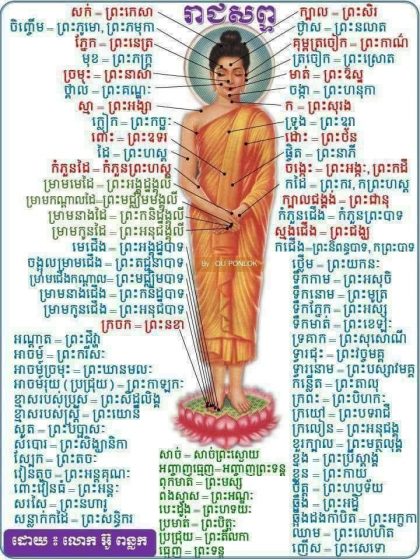
ក្លិននៃពួកសប្បុរសទាំងឡាយក្រអូបច្រាសខ្យល់បាន
ន បុប្ផគន្ធោ បដិវាតមេតិ ន ចន្ទនំ តគរមល្លិកា វា សតញ្ច គន្ធោ បដិវាតមេតិ សព្វា ទិសា សប្បុរិសោ បវាយតិ៕
Fragrance of Virtue Blows Everywhere
ថ្ងៃព្រហស្បតិ៍ ៨រោច ថ្ងៃសីល ខែពិសាខ ឆ្នាំជូត ទោស័ក ព.ស.២៥៦៤ ត្រូវនឹងថ្ងៃទី១៤ ខែឧសភា គ.ស.២០២០
Thursday the 8th Waning Moon of Visakha B.E.2564 equivalent to May 14, A.D.2020 Year of the Rat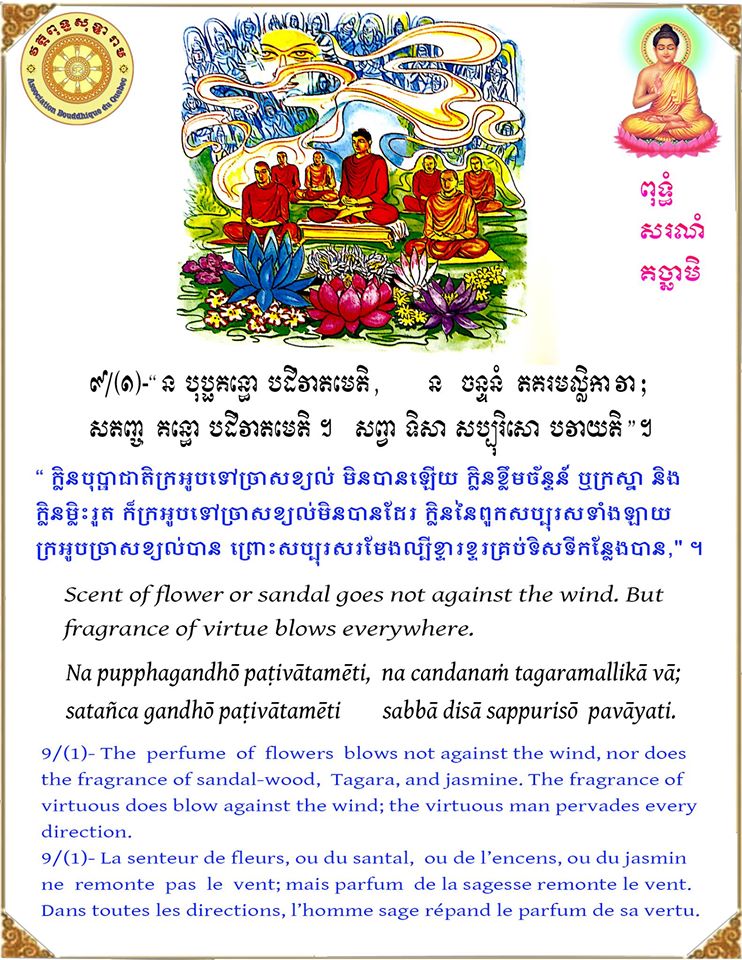
ព្រះសម្មាសម្ពុទ្ធផ្ចាញ់មារ The Buddha Defeating Mara
ថ្ងៃចន្ទ ៤កើត ខែចេត្រ ឆ្នាំច សំរឹទ្ធិស័ក ព.ស.២៥៦២ ត្រូវនឹងថ្ងៃទី៨ ខែមេសា គ.ស.២០១៩
Monday the 4th Waxing Moon of Citta B.E.2562, April 8, A.D.2019 Year of the Dog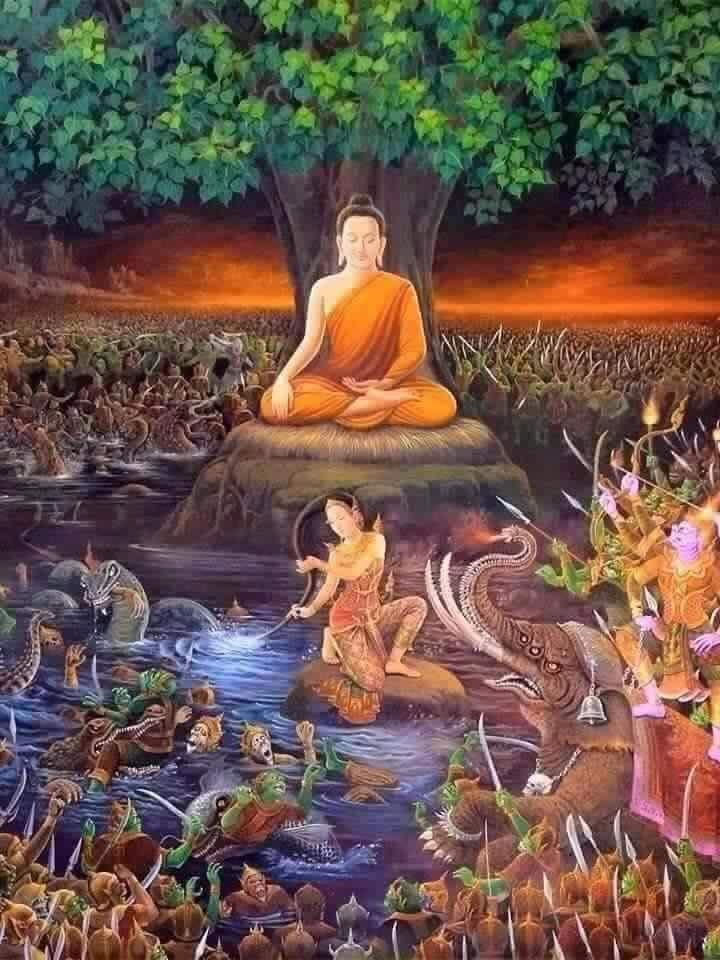
គ្មានការត្រាស់ដឹងរបស់ព្រះសម្មាសម្ពុទ្ធទាំងឡាយណាគ្រប់ព្រះអង្គដែលថាគ្មានមារជាសត្រូវមិនមកផ្ចាញ់ផ្ចាល់់នោះឡើយ ហើយព្រះអង្គមិនមែនចេះខន្តីទុកឲ្យមារជាសត្រូវធ្វើព្យុះភ្លៀងស្រេចតែចិត្តនោះដែរ ព្រះអង្គតបតផ្ចាញ់ផ្ចាល់វិញដោយវិធីរបស់ព្រះអង្គដែលយើងគ្រប់រូបអ្នកគោរពព្រះពុទ្ធសាសនាមិនទាន់យល់ដល់ដូចក្នុងរូបភាពនេះ។
មារមានទាំងនៅក្នុងគន្ធធុរៈ មានទាំងនៅក្នុងវិបស្សនាធុរៈ គឺមាននៅក្នុងចិត្ត មានទាំងនៅខាងក្រៅចាំតែរំខានជុំវិញខ្លួនយើង តែប្រសិនបើយើងមិនតបតកម្ចាត់មារជាសត្រូវទាំងនៅក្នុងចិត្តទាំងនៅចំពោះមុខដោយបញ្ញាទេមាននោះវានៅតែជាឧបស័គ្គរារាំងនូវដំណើរនៃឆាកជីវិតយើងមិនអាចធ្វើដំណើរទៅមុខបានដោយជោគជ័យដល់ទិសដៅបានឡើយ។
ដូច្នេះព្រះអង្គទ្រង់ក៏តបតផ្ចាញ់មារវិញដែរធ្វើឲ្យពួកមារជាសត្រូវរត់ខ្ចាត់ត្រឡប់ទៅវិញអស់ ដូចឈុតឆាកនេះ យើងត្រូវចេះពិចារណាដោយបញ្ញា កុំទុកឲ្យមារជាសត្រូវធ្វើអ្វីមកលើជីវិតយើងស្រេចតែចិត្ត ដូចពាក្យស្លោកពោលថា៖
ផ្លូវវៀចកុំឲ្យបោះបង់ ផ្លូវណាត្រង់ឲ្យដើរផង មិនមែនត្រង់រហូតគេធ្វើបាបខ្លួនប្រាណយើងហើយមិនហ៊ានតបតនោះឡើយ។
មិនគួរចិត្តល្អចំពោះអ្នកដទៃ ហើយឃោរឃៅដាក់ខ្លួនឯងនោះដែរ ចូរពិចារណារកហេតុផលទាំងអស់គ្នា សូមអនុមោទនា។
និព្វាន បកស្រាយដោយសម្ដេចព្រះសង្ឃរាជ ជោតញ្ញាណោ Supreme Patriarch Jotannano on Nibbāna (Nirvāṇa)
និព្វាន បកស្រាយដោយសម្ដេចព្រះសង្ឃរាជ សម្ដេចព្រះមហាសុមេធាធិបតី ជោតញ្ញាណោ
The Revered Supreme Buddhist Patriarch Jotannano of Cambodia on Nibbāna (Nirvāṇa)
Māgha Pūjā at Wat Kiryvongsa Bopharam on FEB 19
វត្ដគិរីវង្សាបុប្ផារាម អាស្រមសមាធិសន្ដិភាព ប្រារព្ធពិធីបុណ្យមាឃបូជា នៅវេលាម៉ោង ២ៈ០០នាទីរសៀល ថ្ងៃអង្គារ ១៥កើត ពេញបូណ៌មី ថ្ងៃសីល ឆ្នាំច សំរឹទ្ធិស័ក ព.ស.២៥៦២ ត្រូវនឹងថ្ងៃទី១៩ ខែកុម្ភៈ គ.ស.២០១៩។ សូមអញ្ជើញពុទ្ធបរិស័ទចូលរួមតាម
លទ្ធភាព។
The Kiryvongsa Bopharam Pagoda, the Peace Meditation Center to observe the Māgha Pūjā at 2:00PM on Tuesday the 15th Waxing Moon of Māgha, Day of Abstinence, B.E.2562 equivalent to February 19, A.D.2019. Buddhists and the public are welcome.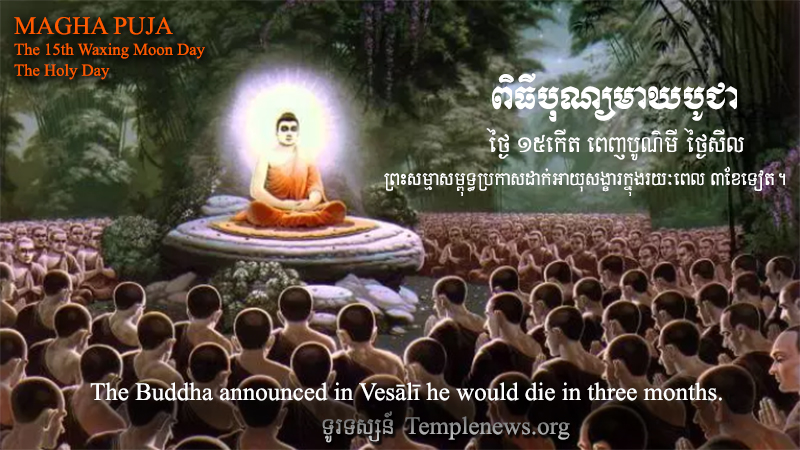
Venue: The Kiryvongsa Bopharam Pagoda, the Peace Meditation Center
100A Cave Hill Road, Leverett, MA 01054 – 9728
Tel.: 413.367.0280, 413.367.2028
Background on មាឃបូជា Māgha Pūjā
Māgha Pūjā is the second most important Buddhist festival, celebrated on the full moon day of the third lunar month in Cambodia, Laos, Thailand, Sri Lanka and on the full moon day of Tabaung in Myanmar. It celebrates a gathering that was held between the Buddha and 1,250 of his first disciples, which, according to tradition, preceded the custom of periodic recitation of discipline by monks. On the day, Buddhists celebrate the creation of an ideal and exemplary community, which is why it is sometimes called Saṅgha Day, the Saṅgha referring to the Buddhist community, and for some Buddhist schools this is specifically the monastic community. In Thailand, the Pāli term Māgha-pūraṇamī is also used for the celebration, meaning ‘to honor on the full moon of the third lunar month’. Finally, some authors have also referred to the day as the Buddhist All Saints Day.
Celebration of Māgha Pūjā is first known of in the modern period, with the institution of it in Thailand, by King Rama IV (A.D.1804 – A.D.1868). It is a public holiday in many Southeast Asian countries and is an occasion when Buddhists go to the temple to perform merit-making activities, such as alms giving, meditation and listening to teachings. It has been proposed as a more spiritual alternative to the celebration of Valentine’s Day.
Māgha is derived from the name of the third month in the traditional Indian lunar calendar, on which the celebration is held. It is also the name of a star, which during this period is close to the full moon. Māgha Pūjā is held on the full moon day. In a leap year, the celebration will be postponed to the full moon day of the fourth lunar month.
Māgha Pūjā day marks an event occurring at the Veḷuvana grove, near Rājagaha (present Rajgir) in northern India, ten months after the enlightenment of the Buddha. The traditional story goes that a meeting is held in the afternoon, that has four characteristics:
1,250 disciples come to see the Buddha that evening without being summoned; These are mostly pupils from the Buddha’s recently converted disciples, such as the three Kassapa brothers, and the monks Sāriputta and Mogallāna.
All of them are Arahants, enlightened disciples;
All have been ordained by the Buddha himself, and therefore are his direct spiritual descendants;
It is the full-moon day of the third lunar month.
Because of these four factors, Māgha Pūjā is also known as the Fourfold Assembly Day. On this occasion, the Buddha teaches those arahants a summary of Buddhism, called the Ovādapatimokkha. In these, three principles are given:
“The non-doing of evil / the full performance of what is wholesome / the total purification of the mind.”
This is followed by a formulation of Buddhist ideals:
“Patience (and) forbearance are the highest austerity. The awakened ones say nibbāna is the highest. One is certainly not a wanderer if one injures others; one is not an ascetic if one harms another.”
Finally, the last stanza is about the path of religious practice:
“Not abusing, not injuring, and restraint under the rules of discipline, and knowing moderation in eating, and secluded lodgings, and exertion in respect of higher thought, this is the teaching of the awakened ones.”
According to the traditional Pāli commentaries, the Buddha continued to teach this summary for a period of twenty years, after which the custom was replaced by the recitation of the monastic code of discipline by the Saṅgha themselves. On Māgha Pūjā, Buddhists celebrate the creation of an ideal and exemplary community.
Māgha Pūjā is also the day that the Buddha is believed to have announced in Vesālī he would die in three months, after which a miraculous earthquake followed. Moreover, in Sri Lanka, it is considered the day that the Buddha appointed his two main disciples, the monks Sāriputta and Moggallāna. Apart from the religious meaning, Māgha Pūjā also reflects the Southeast Asian agricultural year, as it is celebrated after the harvest.
It is unknown how traditional Buddhist societies celebrated this event in pre-modern times, but in Thailand, the first known instance was during the reign of the Thai king Rama IV (1804–68), who instituted it. He first held it in the palace only. In the evening, 31 monks would recite the Ovādapatimokkha, lit lanterns around the ubosot (ordination hall), and give a sermon about the same Ovādapatimokkha. A recitation text used for this occasion is attributed to Rama IV. Rama IV’s successor Rama V (A.D.1853 – A.D.1910) expanded the practice and organized it as a national celebration in the Temple of the Emerald Buddha. From Thailand, the practice spread to neighboring countries. Already in A.D. 1937, the ceremony was widely held and observed in Thailand.
Māgha Pūjā is a day that laypeople make merit. Monastics and devotees will hold processions, light candles, and make offerings. Māgha Pūjā is celebrated most extensively in Cambodia and Thailand, but it is a national holiday in most Southeast Asian countries, such as Laos, Myanmar and Cambodia.
In Thailand, Māgha Pūjā was instituted by Rama IV. It is currently designated as a national holiday, on which sale of alcohol is strictly prohibited. On the evening of Māgha Pūjā, most temples in Thailand hold a candlelight procession. Furthermore, people will make merit by going to temples and by joining in with activities, such as listening to teachings, giving alms, etc. At times, special events are also held, such as a recital of the entire Buddhist scriptures and ceremonies for avowing oneself as a Buddhist lay person. In A.D.2006, the government of Thailand made an announcement that Māgha Pūjā should be celebrated as a “national day of gratitude.” Māgha Pūja was therefore presented as a day of spiritual love and gratitude instead.
In Sri Lanka and Cambodia, Māgha Pūjā is also observed. In Chinese communities, as well as in Myanmar, a similar festival as Māgha Pūjā is observed. The Burmese people celebrate this on the full moon of the month Tabaung according to their traditional calendar. Fifteen days before this full moon day, a Shwedagon Pagoda Festival is held, on which a ceremony is held for offerings to the 28 Buddhas (from Taṇhaṅkara to Gotama Buddha), followed by a 10-day, continuous recital of Buddhist texts. Burmese devotees make merits and meditate during this period.
Māgha Pūjā has also become a popular event among Western Buddhist converts in the West. Wikipedia
5 precepts equal peace
ថ្ងៃព្រហស្បតិ៍ ៦កើត ខែមិគសិរ ឆ្នាំច សំរឹទ្ធិស័ក ព.ស.២៥៦២ ត្រូវនឹងថ្ងៃទី១៣ ខែធ្នូ គ.ស.២០១៨
Thursday the 6th Waxing Moon of Māgasira B.E.2562, December 13, A.D.2018 Year of the Dog
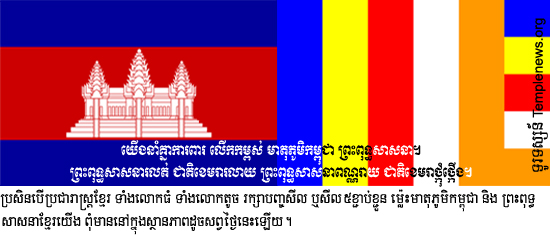
Pali training rules
The following are the five precepts (pañca-sikkhāpada) or five virtues (pañca-sīla) rendered in English and Pali:
1. I undertake the training rule to abstain from killing. Pāṇātipātā veramaṇī sikkhāpadaṃ samādiyāmi.
បាណាតិបាតា វេរមណី សិក្ខាបទំ សមាទិយាមិ
ខ្ញុំព្រះករុណាសូមសមាទាននូវសិក្ខាបទគឺចេតនាជាហេតុវៀរចាកកិរិយាធ្វើសត្វមានជីវិតឲ្យធ្លាក់ចុះកន្លង គឺសម្លាប់សត្វ។
2. I undertake the training rule to abstain from taking what is not given. Adinnādānā veramaṇī sikkhāpadaṃ
samādiyāmi.
អទិន្នាទានា វេរមណី សិក្ខាបទំ សមាទិយាមិ
ខ្ញុំព្រះករុណាសូមសមាទាននូវសិក្ខាបទគឺចេតនាជាហេតុវៀរចាកកិរិយាកាន់យកនូវវត្ថុដែលគេមិនបានឲ្យដោយកាយ ឬដោយវាចា។
3. I undertake the training rule to avoid sexual misconduct. Kāmesumicchācāra veramaṇī sikkhāpadaṃ samādiyāmi.
កាមេសុ មិច្ឆាចារា វេរមណី សិក្ខាបទំ សមាទិយាមិ
ខ្ញុំព្រះករុណាសូមសមាទាននូវសិក្ខាបទគឺចេតនាជាហេតុវៀរចាកកិរិយាប្រព្រឹត្ដខុសក្នុងកាមទាំងឡាយ។
4. I undertake the training rule to abstain from false speech. Musāvādā veramaṇī sikkhāpadaṃ samādiyāmi.
មុសាវាទា វេរមណី សិក្ខាបទំ សមាទិយាមិ
ខ្ញុំព្រះករុណាសូមសមាទាននូវសិក្ខាបទគឺចេតនាជាហេតុវៀរចាកកិរិយាពោលនូវពាក្យកុហក។
5. I undertake the training rule to abstain from fermented drink that causes heedlessness.
Surāmerayamajjapamādaṭṭhānā veramaṇī sikkhāpadaṃ samādiyāmi.
សុរាមេរយមជ្ជប្បមាទដ្ឋានា វេរមណី សិក្ខាបទំ សមាទិយាមិ
ខ្ញុំព្រះករុណាសូមសមាទាននូវសិក្ខាបទគឺចេតនាជាហេតុវៀរចាកហេតុជាទីតាំងនៃសេចក្ដីប្រមាទ គឺផឹកនូវទឹកស្រវឹង គឺសុរា
និងមេរ័យ។
For more on the first precept, see ahimsa. In the fifth precept sura, meraya and majja are kinds of alcoholic beverages. In some modern translations, Surāmerayamajjapamādaṭṭhānā, is rendered more broadly, variously, as, intoxicants, liquor and drugs, etc. Courtesy wikipedia
អាចារ្យក្មេង គិម វរានន្ទ អាយុ ៩ឆ្នាំ សូត្រធម៌ វន្ទាមិ ចេតិយំ
អាចារ្យក្មេង គិម វរានន្ទ អាយុ ៩ឆ្នាំ សូត្រធម៌ វន្ទាមិ ចេតិយំ
Buddhist monks must not practice superstition
ដាច់បាយអ្នកប្រកបអជីពនេះហើយបើចឹងមែន! ប្រសិនបើបួសតាមព្រះពុទ្ធ ត្រូវយល់ដឹងព្រះវិន័យ ៣ចំណុចៈ
👉 ភិក្ខុសាមណេរស្រោចទឹកឲ្យគ្រហស្ថ ដែលមិនមែនជាញោមប្រុសស្រីបង្កើតរបស់ខ្លួនឯង ត្រូវអាបត្តិទុក្កដ (ព្រោះការធ្វើសាមីចិកម្មដល់គ្រហស្ថ) ។
ចំណែកឯគ្រហស្ថវិញ ប្រើព្រះសង្ឃអ្នកមានសីលឲ្យស្រោចទឹកឲ្យនឹងមានទោស គឺបាប (កើតជាតិក្រោយនឹងជាខ្ញុំបម្រើគេ) ។
👉 ភិក្ខុសាមណេររៀនមន្តអាគមឩមអាមក្រៅព្រះពុទ្ធសាសនា (គឺព្រះត្រ័យបិដក) ត្រូវអាបត្តិទុក្កដ ព្រោះរៀនតិរច្ឆានវិជ្ជា (គឺវិជ្ជាដែលទទឹងផ្លូវសួគ៌និងនិព្វាន) ។
👉 ភិក្ខុសាមណេរចិញ្ចឹមជីវិតដោយការធ្វើយ័ន្ត កន្សែងយ័ន្ត ខ្សែកថា ឬស្តោះព្រួសជាដើម ត្រូវអាបត្តិទុក្កដ ព្រោះប្រកបក្នុងមិច្ឆាជីវៈ គឺការចិញ្ចឹមជីវិតខុស ។
-អាគមឩមអាម ព្រះពុទ្ធទ្រង់ហាមមិនឲ្យអ្នកបួសរៀនសូត្រកួចកាន់ ប្រកាន់ជ្រុលជ្រួស ភ្លេចគិតសីលផ្នួស ដើរស្តោះព្រួសគេ ។
ស្រង់ចាកវចនានុក្រមសម្តេចសង្ឃរាជ ជោតញ្ញាណោ ជួន ណាត
ប្រភព ឆាយ ឆាយា Chhaya Chhay
សាលាបាលីដំបូងបង្អស់នៅកម្ពុជា មានឈ្មោះថា បរមពុទ្ធវចនបរិយត្តិបាសាន
អាចារ្យក្មេង អាយុ ៨ឆ្នាំ
អាចារ្យក្មេង អាយុ ៨ឆ្នាំ ដឹកនាំពុទ្ធបរិស័ទខ្មែរ ដើម្បីវេរចង្ហាន់ប្រគេនដល់ព្រះសង្ឃ
8-year-old Buddhist laypeople’s leader leading Khmer devotees to offer meal to the Buddhist monk
at Wat Kiryvongsa Bopharam
Sarabhanna
បទសរភញ្ញ Sarabhanna
ព្រះរាជនិពន្ធដោយសម្ដេចព្រះមហាសុមេធាធិបតី ជោតញ្ញាណោ ព្រះសង្ឃរាជនៃកម្ពុជា និងជាបិតាអក្សរសាស្ដ្រខ្មែរ
Composed by His Holiness Sangharaja Jotannano, the Supreme Buddhist Patriarch of Cambodia and Father of Modern Khmer Language
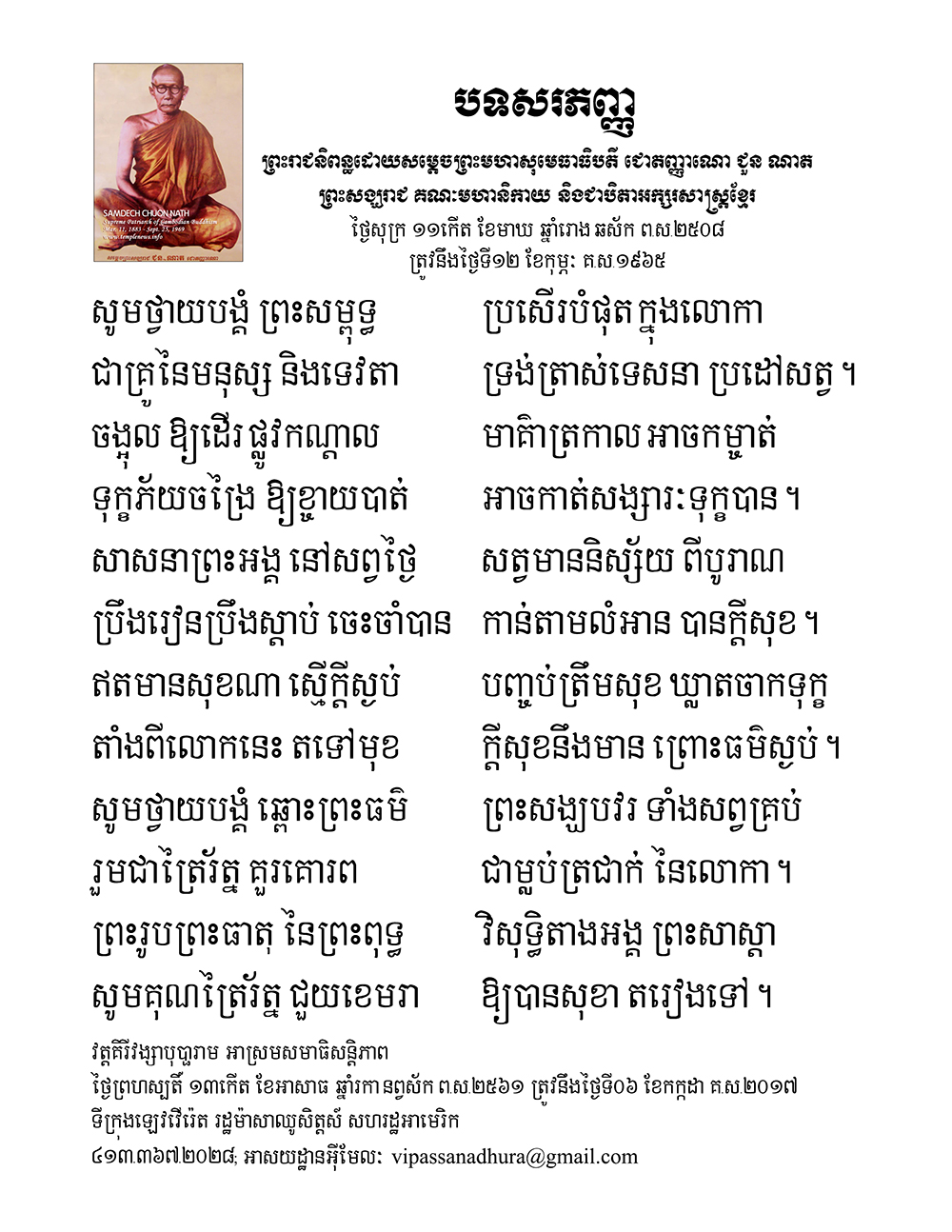
Download PDF for printing quality: Sarabhanna
(more…)
Visakha Puja: Commemorating the Birth, Enlightenment, Mahaparinibbana of the Lord Buddha
Victory breeds hatred
ជ័យជម្នះបង្កើតសេចក្ដីស្អប់ខ្ពើមក្នុងជនដែលឈ្នះ។ ជនទទួលបរាជ័យរស់ក្នុងទុក្ខព្រួយ។ សេចក្ដីលះបង់ទាំងពីរក្នុងជ័យជម្នះនិងបរាជ័យ ជនមានសេចក្ដីស្ងប់រស់ក្នុងសន្ដិភាព។
Jayam veram pasavti – dukkham seti parājito
Upasanto sukham seti – hitvā jayaparājayam
Victory breeds hatred in the conquered. The defeated live in sorrow. Giving up both victory and defeat, the appeased live in peace.
ឈ្នះក៏ពុំមានសេចក្ដីស្ងប់ ចាញ់ក៏ពុំមានសេចក្ដីស្ងប់នៅក្នុងវាលវដ្ដសង្សារ។
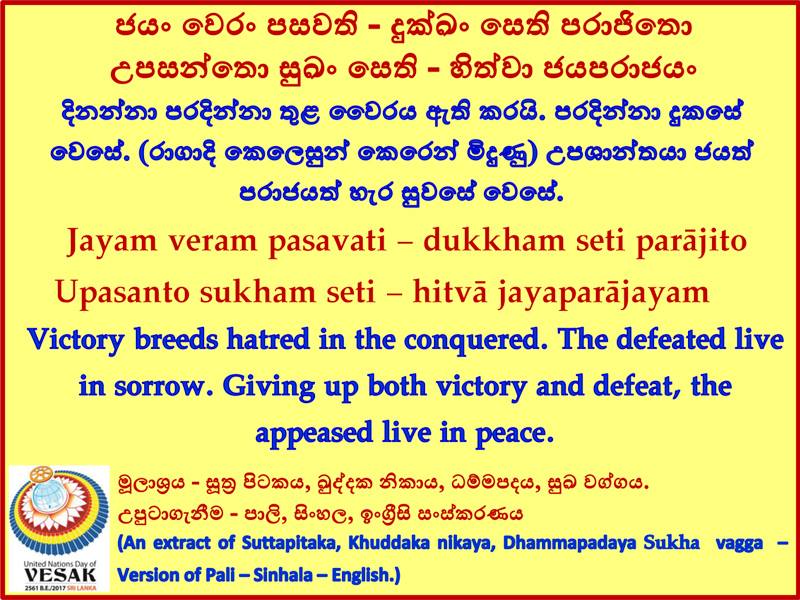
Faith and Wisdom
បុព្វហេតុសាសនាគឺការស្វែងរកចម្លើយប្រស្នានៃទុក្ខ។ ហេតុនេះចម្លើយត្រូវបានគេរកឃើញខុសៗគ្នា ។ ព្រះពុទ្ធរកឃើញថា កាលណាគេយល់ពីរបៀបរស់នៅ យល់ការពិតរបស់ជីវិត យល់ពីសច្ចភាពនៃសកលចក្កវាឡ គេក៏បានស្ងប់ចិត្ត ហើយសោះអង្គើយនឹងភាពឥតប្រយោជន៍ ។ ការប្រឡាក់ប្រឡូសជាមួយអកុសលធម៌ដែលនាំឲ្យជំពាក់វាក់វិនក្នុងភព ជាតិ ជរា ព្យាធិ មរណៈ ដែលហៅថាវដ្ដទុក្ខមិនមានទីបំផុត ។ ខ្លះយល់ថា ការស្លាប់ជៀសមិនផុតដដែល កុំពិបាកចិត្ត នាំគ្នារាំច្រៀងក្នុងវិហារសរសើរព្រះទៅ ព្រោះឲ្យតែយើងគោរពជឿលើព្រះ គោរពតាមព្រះបន្ទូលរបស់ទ្រង់ យើងនឹងបានលាងអំពើបាបទាំងអស់ ហើយបានរស់នៅនគរផងព្រះ មានជីវិតមានកប្បជានិច្ច ក្រោមសិរីរុងរឿងរបស់ទ្រង់ ឲ្យតែយើងជឿដឹងតែបានឡើងឋានសួគ៌ហើយ ទោះបីជឿបានកន្លះដង្ហើមហើយស្លាប់ក៏ដោយ ។
(more…)
Māgha Pūjā
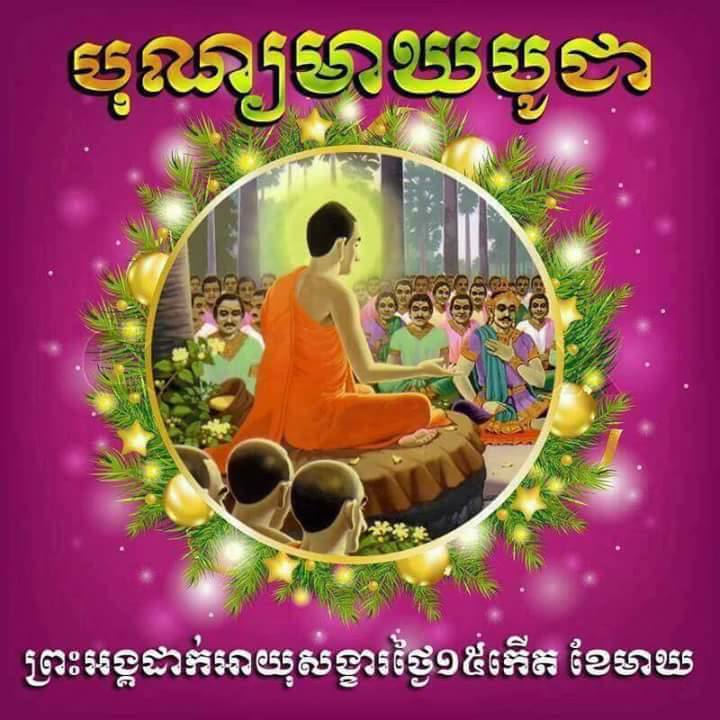
Māgha Pūjā is an important Buddhist festival celebrated on the full moon day of Māgha in Cambodia, Laos, Thailand and Sri Lanka and on the full moon day of Tabodwe in Myanmar. The spiritual aims of the day are not to commit any kind of sins; do only good; purify one’s mind. Māgha Pūjā is a public holiday in Cambodia, Laos, Myanmar, Sri Lanka and Thailand and is an occasion when Buddhists tend to go to the temple to perform merit-making activities.
The third lunar month is known in the Thai language as Makha (Pali: Māgha); Bucha is also a Thai word (Pali: Pūjā), meaning “to venerate” or “to honor”. As such, Makha Bucha Day is for the veneration of Buddha and his teachings on the full moon day of the third lunar month.
Māgha Pūjā day marks the four auspicious occasions occurring at the Veḷuvana bamboo grove, near Rājagaha in northern India ten months after the enlightenment of the Buddha. On that occasion, as recorded in the commentary to the Mahāsamayasutta, DN-Comm 20) four marvellous events occurred:
1,250 disciples came to see the Buddha that evening without being summoned.
All of them were Arahants, Enlightened Ones, and
All were ordained by the Buddha himself: Ehibhikkhus.
It was the full-moon day.
On this occasion the Buddha gave those Arahants the principles of Buddhism, called “The ovadapatimokha”.[5] Those principles are: To cease from all evil; To do what is good; To cleanse one’s mind. In Thailand, this teaching has been dubbed the “heart of Buddhism”. Wikipedia
MEDITATION DOCUMENTARIES
DHAMMA TALK BY VEN. KETODHAMMO
ព្រះធម្មទេសនាសំដែងដោយ ព្រះធម្មវិបស្សនា កេតុធម្មោ សំ ប៊ុនធឿន
Dhamma talk by the late and renowned Cambodian Vipassana Buddhist Master Ven. Ketodhammo Som Bunthoeun.
TEMPLENEWS TV SHOWS
Watch our shows on LTC – Channel 95
Broadcast hours | Fridays: 4 – 5 pm, 8 – 9 pm
Tuesdays 11 am - 12 pm
Email: templenewscast@yahoo.com
Phone: 978.853.9623
Website: templenews.org
Youtube: www.youtube.com/templenewstv
To find out more, including how to control cookies, see here: Cookie Policy
